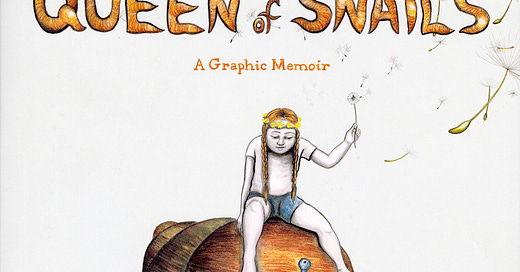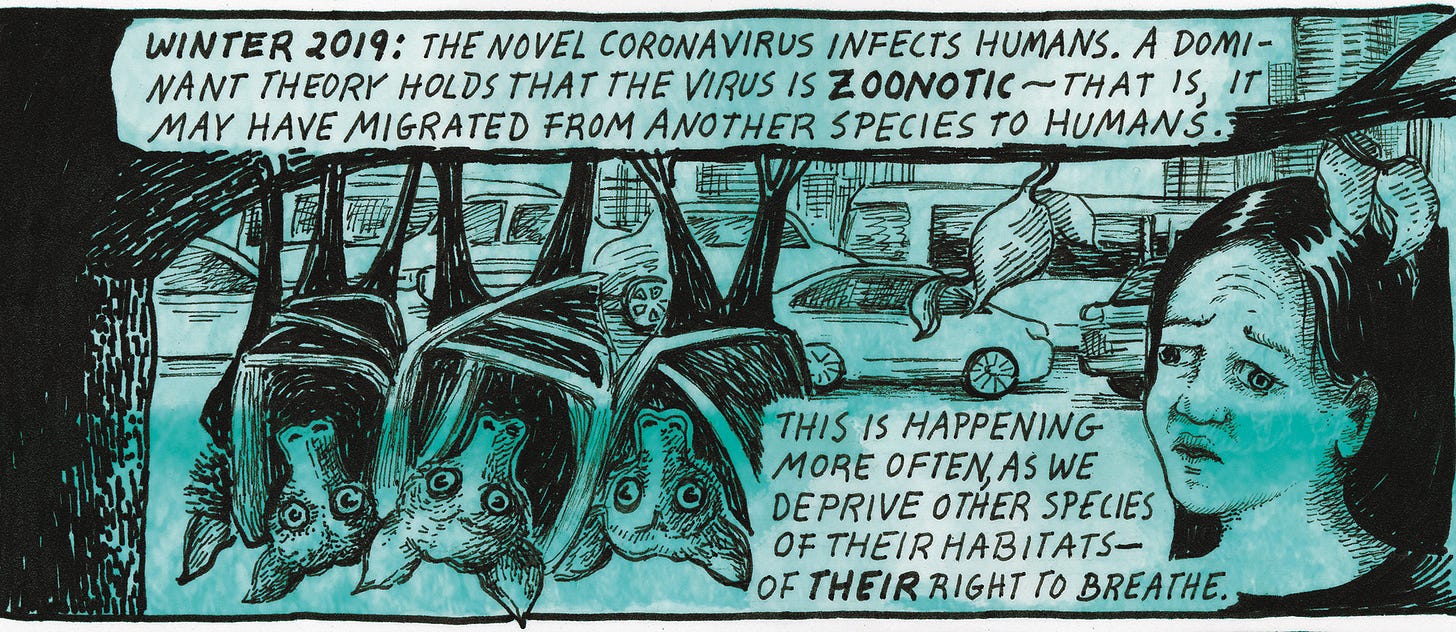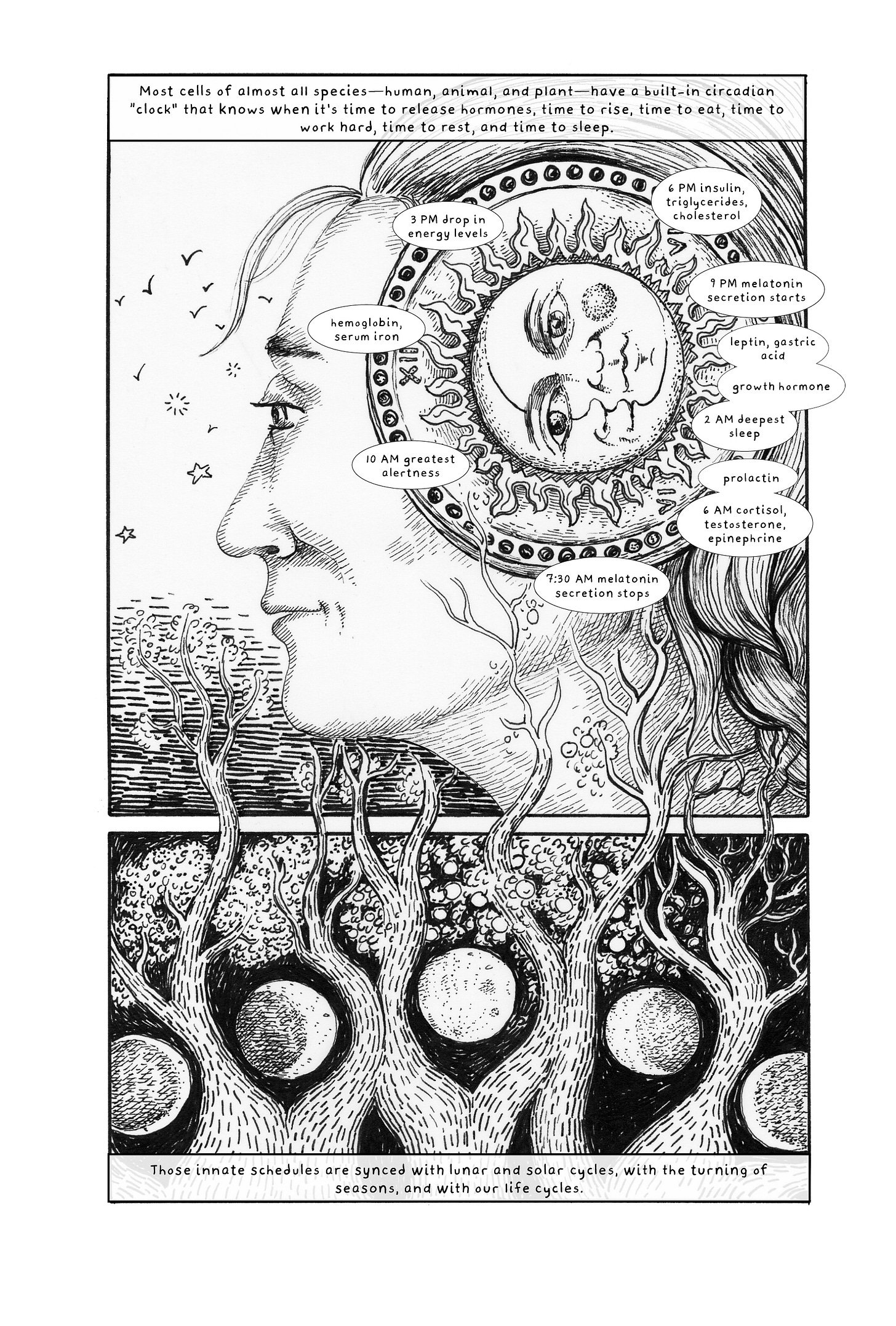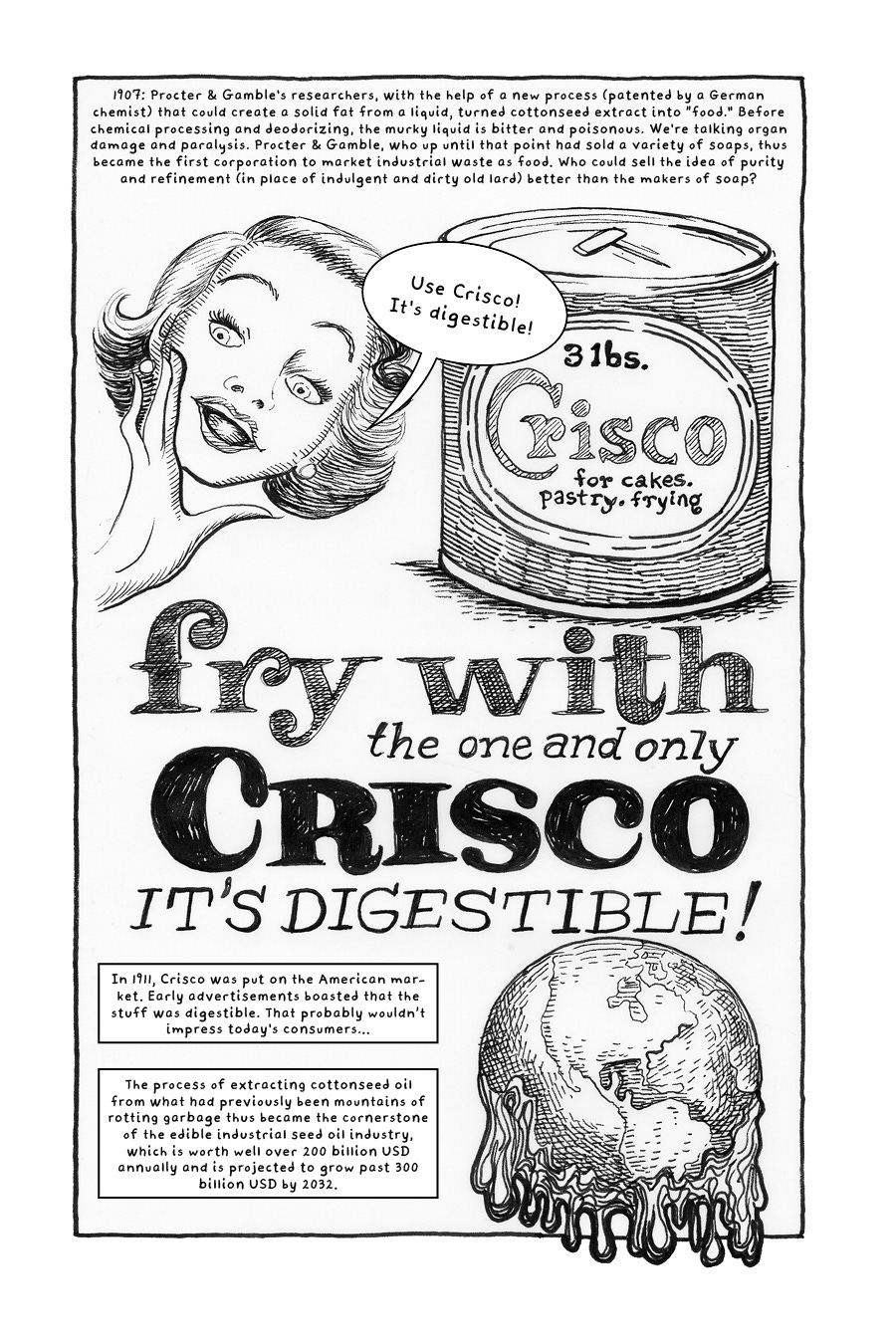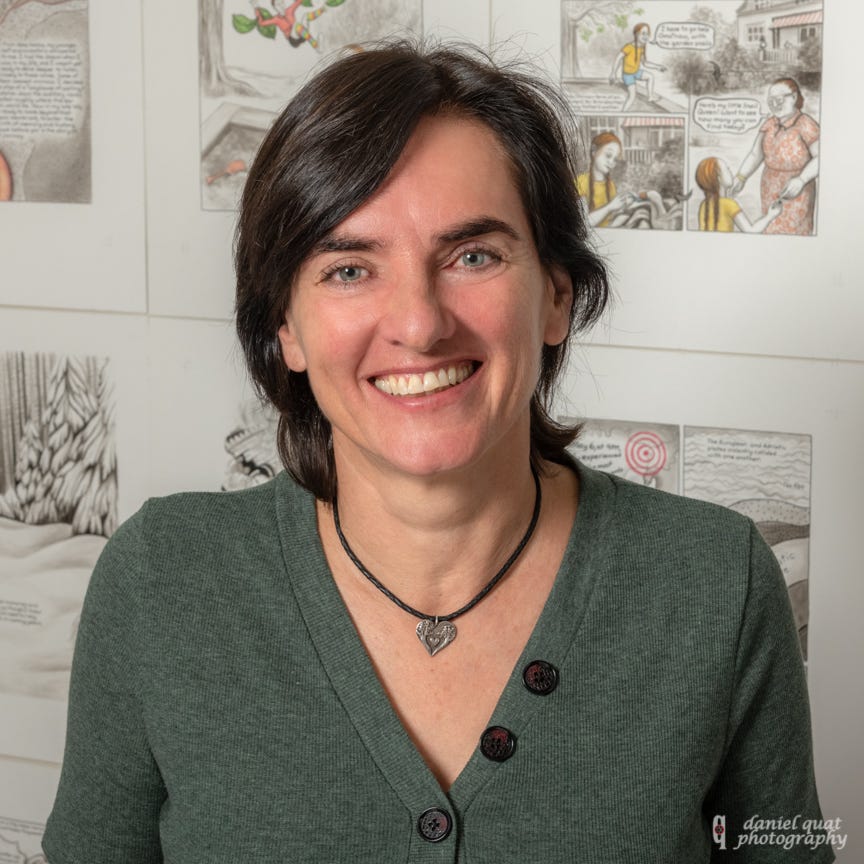An Interview with Maureen Burdock
I (Amaris) had the pleasure of meeting Maureen Burdock at the Graphic Medicine Conference in Toronto last summer—then I realized that we both live in New Mexico! Maureen was gracious enough to come hear me read some X-Files-inspired poetry in Santa Fe and grab breakfast after. Unable to put it down, I inhaled her graphic memoir, Queen of Snails.
Describe your comics journey—how did you get into making comics?
As an eight-year-old German immigrant kid in Chicago, I’d just learned English the year before. I wrote an illustrated short story about two sausages who escaped from a frying pan by leaping out the window, only to be devoured by a passing dog. The story won a regional prize which included meeting a real-life children’s book author. This was the beginning of my career as a creator of stories with pictures. Even the theme of trauma was already visible in my early work there (metamorphosing difficulties through comics is what I still do today)!
Fast-forward to my thirties. Before that, for a long time, I didn’t know I was a cartoonist. I was a painter who sometimes also made installation and sound art and artist’s books. I knew I was a graphic storyteller, but somehow I hadn’t made the connection to comics yet. That changed at the Border Book Festival in Las Cruces, New Mexico, back in 2006. There I met a group of amazing cartoonists from Juarez, Mexico. They call themselves 656 Comics after the Juarez area code. These socially engaged, passionate, and incredibly talented artists and writers showed me what comics can do, which was more persuasive to me than what comics are. They invited me to come and have an exhibition in their Juarez gallery space, to which I happily agreed. On my way home from Las Cruces, I conceived my first graphic “novel,” a 132-page collection of Feminist Fables for the Twenty-First Century that McFarland Books published nine years later, in 2015, with a foreword by the wonderful Trina Robbins. The first of these fables, “Marta & the Missing (Marta y Las Desaparecidas),” was the art we hung at the Juarez gallery. The others were the results of working with feminist artists, activists, and educators across cultures.
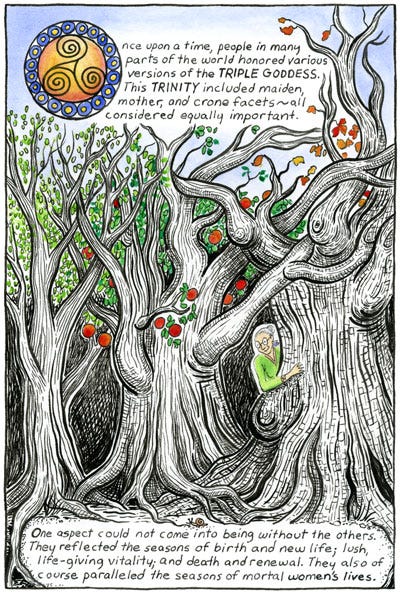
How did you develop your comics “voice”?
I grew up between cultures, so I was exposed to eclectic forms of illustrated children’s literature, American cartoons and comics, and art and films (Brecht’s Three Penny Opera, which I saw at age nine, was life-changing for me) from Europe and the Americas. I was an only child with a single working mom who didn’t approve of television but always made sure I had access to a mountain of books in German and in English. Thus, I read and drew constantly! You can read more about my calamitous and colorful childhood in Queen of Snails: A Graphic Memoir (Graphic Mundi, 2022). I also spent hundreds of hours alone in Chicago’s fine museums (art, natural history, and science and industry) and roaming the streets talking to strangers like a very young sociologist with the hypothesis that the world is brutal but its people fascinating and mostly good or at least benign. The brutality is thanks to just a few idiots with way too much money and power. I formed strong opinions about the patriarchy early on, with little help from anyone or anything but my lived experiences and Pippi Longstocking.
I’d say I developed my unique voice because of these empirically collected convictions and by falling in love with women surrealists like Leonora Carrington, Remedios Varo, and Frida Kahlo. Their visionary responses to cruel personal and political circumstances moved me very deeply and I wanted to emulate them to some extent by forming my own responses to what I’d experienced and was seeing in the world around me. When you’re young and you’re a survivor of trauma and you have few distractions, art and literature can become a lifeline of connection to those who have weathered difficulties before you. That lifeline helped me survive loneliness and a broken sense of self and belonging.
On a lighter note, I also loved reading Asterix and German detective comics featuring Micky Mouse, Goofy, and Donald Duck. But I wasn’t exposed to contemporary comics that held any real meaning for me until later, when, as a young adult queer woman, I found Alison Bechdel’s Dykes to Watch Out For, and then Phoebe Gloeckner’s A Child’s Life and Diane Dimassa’s Hothead Paisan. It took even longer until I first encountered German Jewish Charlotte Salomon’s amazing body of work, Life? Or Theater? (which she created before losing her life in the Holocaust). When I saw that at San Francisco’s Contemporary Jewish Museum, I felt like I’d found my true creative kindred spirit.
In my early adulthood, when I defined myself as a painter, I didn’t feel connected to a real community. As much as I tried, I just couldn’t seem to breathe the same rarified air as successful artists, and this was a great source of frustration and loneliness for me. Connecting with creators of comics was a very different experience! Right away I felt at home. In 2010, at the invitation of the lovely artist and scholar Sarah Lightman (creator of Book of Sarah and cofounder of Laydeez Do Comics), I attended the Thought Bubble Conference (my first comics conference) in Leeds, England. There I met Ian Williams and became acquainted with the Graphic Medicine community. This eclectic international group of people has been a great inspiration and intellectual/creative home for me as someone interested in comics and healing.
What are some of the joys and challenges of making nonfiction comics?
I’d say that the challenges are part of the joy. I love doing research! Both the scholarly research (I did my PhD in cultural studies with a graphic dissertation and loved every moment of those seven years!) and the visual research satisfy my perpetual curiosity. The biggest challenge is probably just negotiating enough time to do it all because I can’t seem to help but go down a ton of rabbit holes. I just love finding and forging connections! This means my research and the creation of my nonfiction graphic narratives is very time-consuming. But ask Alice (in Wonderland)! Time and space are very curious things that are more malleable than one might think.
Are you working on something now?
Yes! I’m working on a book about sleep, or lack thereof. The title I’ve been using is Sleepless Planet: A Graphic Guide to Coping with Insomnia. It’s under contract with Graphic Mundi. I’ve used the four elements as organizing principle. I start with AIR and breath, breathing. It turns out most of us, myself included, have forgotten how to optimally breathe! A huge number of people suffer from sleep apnea, and it turns out we have “email apnea” as well (over 80% of office workers hold their breath routinely).
Then I explore FIRE and the metabolism. This was really eye-opening for me. I learned that 90% of us living in the U.S. are metabolically unwell and began working on my own metabolic health, which changed a lot of things for me. I actually enrolled in the Institute for Integrative Nutrition (IIN) to become certified as a nutrition coach so that I can help people more directly.
Now I’m working on EARTH and the circadian rhythm. We are overwhelmingly used to ignoring our circadian clocks—to our great detriment—because we’re beholden to and oppressed by capitalist time.
Finally, I will explore WATER and fluid emotions, releasing stress and trauma and becoming more flexible/adaptable. The process of creating this work has been life changing and I hope it will be that for readers, even those who don’t struggle with sleep.
I have a crowdfundr. set up for this project here.
Here is my website where you can get a signed copy of Queen of Snails and also a deck of sleep tip cards.
Upcoming talks and classes:
I’ll be at Pride and Panels at the San Francisco Public Library on Sunday, February 18.
I’ll be giving a talk about Sleepless Planet at University of California, Davis, on February 22nd.
I’ll be teaching a four-week course on Creative Nonfiction Comics at Sequential Artists Workshop (SAW) starting this April. You can sign up here.
Maureen Burdock is a graphic storyteller and integrative wellness coach (in other words, a witch who makes comics). She lives in Santa Fe, New Mexico, and loves running and hiking on trails with her pack comprised of family, friends, and a boxer dog named Gracie. Burdock is the creator of Feminist Fables for the Twenty-First Century and Queen of Snails: A Graphic Memoir. Her next book is Sleepless Planet: A Graphic Guide to Coping with Insomnia.
Socials: @mburdock on Facebook and maureenburdock on Instagram and @BurdockMaureen on X (I'm not a big Twitter/X user though).

